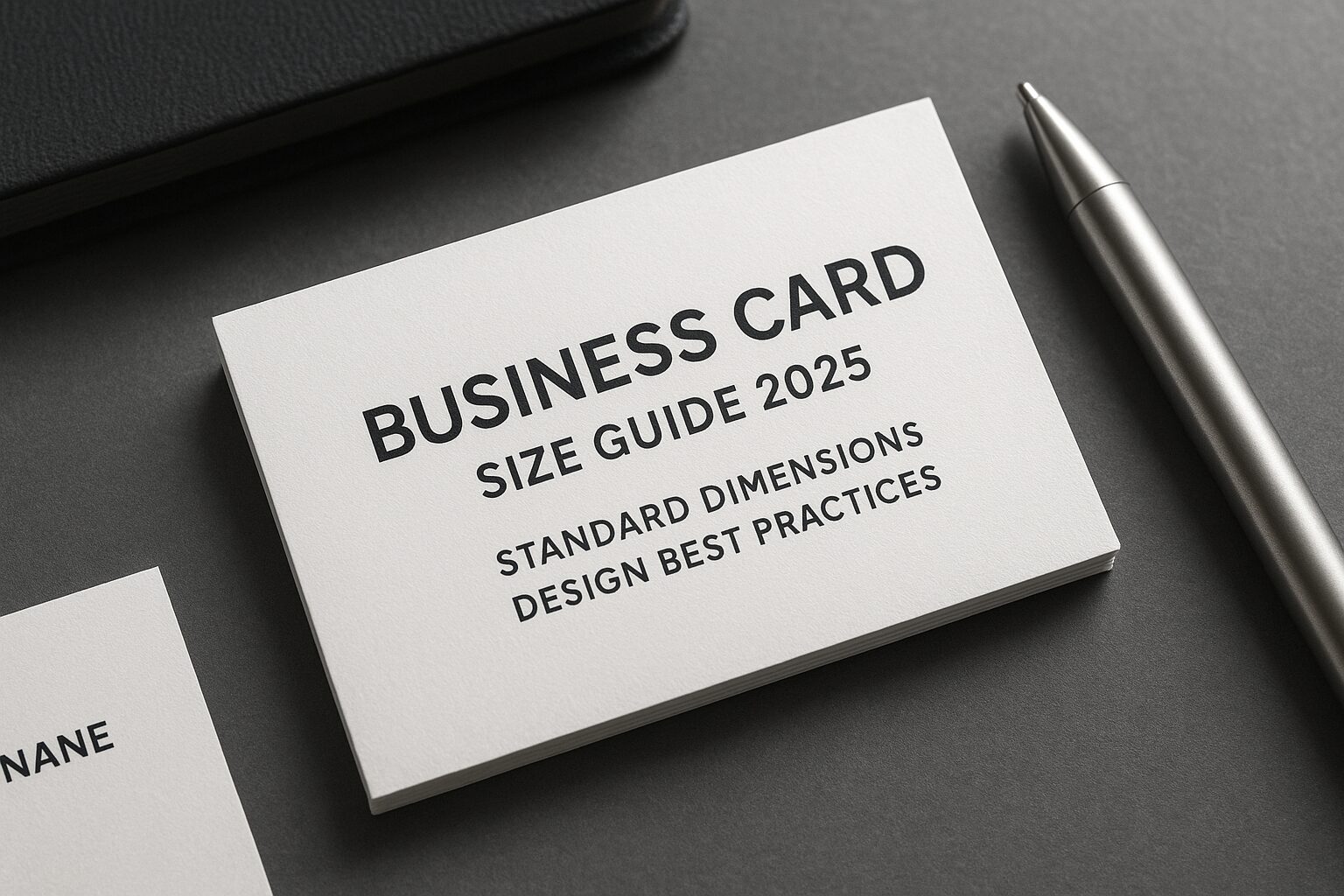Business cards remain one of the most powerful tools for personal and professional networking, even in 2025. Despite the rise of digital contacts, a well-designed business card still leaves a tangible impression. The right business card size combined with thoughtful design ensures that your card stands out and reflects your brand identity.
This guide covers everything you need to know about standard dimensions, orientation, design best practices, printing tips, and current trends in 2025. By the end, you’ll be equipped to create business cards that make a lasting impact.
Standard Business Card Sizes
1. Global Standard Sizes
Business cards vary across regions. Understanding standard sizes helps ensure your cards are practical and professional.
- North America: 3.5 x 2 inches (88.9 x 50.8 mm) – the most common size in the U.S. and Canada.
- Europe: 85 x 55 mm – slightly wider and fits perfectly in European wallets.
- Asia: 90 x 54 mm – often used in countries like Japan and China.
2. Non-Standard / Custom Sizes
Some professionals opt for unique dimensions to stand out.
- Square Cards: Typically 2.5 x 2.5 inches; unique but less wallet-friendly.
- Mini Cards: Compact and portable, often 3 x 1.5 inches.
- Folded Cards: Double the information space, ideal for portfolios or detailed contact info.
3. Considerations for Choosing the Right Size
- Wallet Compatibility: Cards should fit standard wallets or cardholders.
- Printing Costs: Larger or custom shapes may increase production expenses.
- Industry Preferences: Creative industries often prefer distinctive sizes; traditional sectors lean towards standard dimensions.
Business Card Orientation
1. Horizontal vs Vertical
- Horizontal Orientation: The classic layout, works for most professional settings, and allows natural reading flow.
- Vertical Orientation: Modern and sleek, ideal for creative professions and making a visual statement.
2. When to Use Unique Orientations
- Creative Industries: Graphic designers, photographers, and artists benefit from vertical or unconventional layouts.
- Brand Differentiation: Unique orientations can reflect innovation and brand personality.
Design Best Practices
1. Layout and Margins
Ensure your card has safe zones and bleed areas to prevent essential information from being cut off during printing. Typically, keep a 3mm margin around the edges.
2. Typography
- Readability Tips: Use simple, clear fonts; avoid overly decorative fonts that hinder readability.
- Font Size Recommendations: Name and company title should be 10–12 pt, contact info 8–10 pt.
3. Color Schemes
- Branding Consistency: Use colors that reflect your brand identity.
- Contrast and Legibility: Ensure text stands out against the background for easy reading.
4. Logo Placement
Position your logo where it’s clearly visible but doesn’t overpower contact information. Typically, top-left or top-center works well.
5. Contact Information
Include essential details such as name, job title, company, phone number, email, and website. Consider adding QR codes for digital contact sharing.
Printing Considerations
1. Paper Types and Finishes
- Matte: Smooth, non-reflective finish; elegant and professional.
- Glossy: Shiny and eye-catching; may show fingerprints.
- Textured: Adds a tactile experience; perfect for luxury brands.
2. Special Printing Techniques
- Embossing: Raises text or logo for a premium feel.
- Foil Stamping: Metallic finishes for highlights.
- Spot UV: Shiny accents that draw attention to key elements.
3. Digital vs Offset Printing
- Digital Printing: Cost-effective for small batches; fast turnaround.
- Offset Printing: High-quality output for large orders; more expensive.
Visual Example:
Graph showing popularity and cost comparison of digital vs offset printing.
Trends in 2025
1. Minimalist Designs
Less is more. Clean layouts with limited colors and essential information dominate the market.
2. Eco-Friendly Materials
Sustainable paper, recycled materials, and plantable cards appeal to environmentally conscious clients.
3. Integration with Digital Tools
- NFC-Enabled Business Cards: Tap-to-share contact info with smartphones.
- QR Codes: Link directly to websites, portfolios, or social media profiles.
Common Mistakes to Avoid
- Overcrowding Information: Less clutter improves readability.
- Choosing Impractical Sizes: Ensure your card fits wallets or standard holders.
- Ignoring Brand Consistency: Colors, fonts, and logos should reflect your brand.
FAQs
Q1: What is the most common business card size worldwide?
The most common standard size is 3.5 x 2 inches (88.9 x 50.8 mm) in North America.
Q2: Can I create custom-sized business cards?
Yes, square, mini, or folded cards are popular, especially in creative industries, but they may cost more to print.
Q3: How do I make sure my business card prints correctly?
Use high-resolution files (300 dpi), maintain safe margins, and consult your printer regarding bleed areas and color profiles.
Q4: Should I include a QR code on my business card?
Yes, QR codes are increasingly popular to share digital contacts, websites, or portfolios efficiently.
Q5: What paper type is best for business cards?
Matte is ideal for professional settings, glossy works for visual impact, and textured paper adds a premium feel.
Q6: How many business cards should I print at once?
Typically, print 250–500 cards for standard usage, but adjust according to your networking needs.
Q7: Can I use both sides of a business card?
Yes, using both sides allows more information or branding without overcrowding.
Q8: Are digital business cards a replacement for physical cards?
Digital cards complement physical cards, providing convenience while maintaining a personal touch.
Q9: What font styles are recommended for business cards?
Stick to clean, readable fonts like Helvetica, Arial, or Roboto to ensure clarity.
Q10: Can I use images or photos on my business card?
Yes, but use them sparingly to avoid clutter and maintain professional appeal.
Conclusion
Choosing the right business card size and following design best practices ensures that your card leaves a lasting impression. In 2025, trends favor minimalist layouts, eco-friendly materials, and digital integration. Whether you stick to standard dimensions or experiment with creative designs, make sure your card aligns with your brand identity.
A well-crafted business card is more than just contact information—it’s a reflection of you and your business.
Disclaimer
This guide provides general information on business card sizes and design best practices. Individual printing results may vary. Always consult with your professional printer for exact specifications and recommendations.



